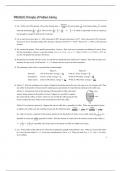PROLOGUE: Principles of Problem Solving
distance 1 1
1. Let r be the rate of the descent. We use the formula time ; the ascent takes h, the descent takes h, and the
rate 15 r
2 1 1 1 1 1
total trip should take h. Thus we have 0, which is impossible. So the car cannot go
30 15 15 r 15 r
fast enough to average 30 mi/h for the 2mile trip.
2. Let us start with a given price P. After a discount of 40%, the price decreases to 06P. After a discount of 20%, the price
decreases to 08P, and after another 20% discount, it becomes 08 08P 064P. Since 06P 064P, a 40% discount
is better.
3. We continue the pattern. Three parallel cuts produce 10 pieces. Thus, each new cut produces an additional 3 pieces. Since
the first cut produces 4 pieces, we get the formula f n 4 3 n 1, n 1. Since f 142 4 3 141 427, we
see that 142 parallel cuts produce 427 pieces.
4. By placing two amoebas into the vessel, we skip the first simple division which took 3 minutes. Thus when we place two
amoebas into the vessel, it will take 60 3 57 minutes for the vessel to be full of amoebas.
5. The statement is false. Here is one particular counterexample:
Player A Player B
First half 1
1 hit in 99 atbats: average 99 0 hit in 1 atbat: average 01
Second half 1 hit in 1 atbat: average 11 98 hits in 99 atbats: average 98
99
Entire season 2
2 hits in 100 atbats: average 100 99
99 hits in 100 atbats: average 100
6. Method 1: After the exchanges, the volume of liquid in the pitcher and in the cup is the same as it was to begin with. Thus,
any coffee in the pitcher of cream must be replacing an equal amount of cream that has ended up in the coffee cup.
Method 2: Alternatively, look at the drawing of the spoonful of coffee and cream cream
mixture being returned to the pitcher of cream. Suppose it is possible to separate
the cream and the coffee, as shown. Then you can see that the coffee going into the coffee
cream occupies the same volume as the cream that was left in the coffee.
Method 3 (an algebraic approach): Suppose the cup of coffee has y spoonfuls of coffee. When one spoonful of cream
cream 1 coffee y
is added to the coffee cup, the resulting mixture has the following ratios: and .
mixture y1 mixture y1
1
So, when we remove a spoonful of the mixture and put it into the pitcher of cream, we are really removing of a
y1
y
spoonful of cream and spoonful of coffee. Thus the amount of cream left in the mixture (cream in the coffee) is
y 1
1 y
1 of a spoonful. This is the same as the amount of coffee we added to the cream.
y 1 y1
7. Let r be the radius of the earth in feet. Then the circumference (length of the ribbon) is 2r. When we increase the radius
by 1 foot, the new radius is r 1, so the new circumference is 2 r 1. Thus you need 2 r 1 2r 2 extra
feet of ribbon.
1
, 2 Principles of Problem Solving
8. The north pole is such a point. And there are others: Consider a point a1 near the south pole such that the parallel passing
through a1 forms a circle C1 with circumference exactly one mile. Any point P1 exactly one mile north of the circle C1
along a meridian is a point satisfying the conditions in the problem: starting at P1 she walks one mile south to the point a1
on the circle C1 , then one mile east along C1 returning to the point a1 , then north for one mile to P1 . That’s not all. If a
point a2 (or a3 , a4 , a5 , ) is chosen near the south pole so that the parallel passing through it forms a circle C2 (C3 , C4 ,
C5 , ) with a circumference of exactly 12 mile ( 13 mi, 14 mi, 15 mi, ), then the point P2 (P3 , P4 , P5 , ) one mile north
of a2 (a3 , a4 , a5 , ) along a meridian satisfies the conditions of the problem: she walks one mile south from P2 (P3 , P4 ,
P5 , ) arriving at a2 ( a3 , a4 , a5 , ) along the circle C2 (C3 , C4 , C5 , ), walks east along the circle for one mile thus
traversing the circle twice (three times, four times, five times, ) returning to a2 (a3 , a4 , a5 , ), and then walks north one
mile to P2 ( P3 , P4 , P5 , ).





